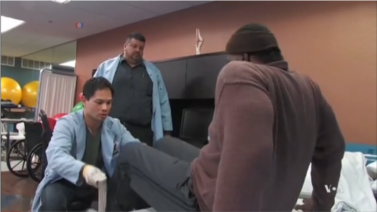On August 1, 2007, a steel bridge in Minneapolis, Minnesota, collapsed, sending people and vehicles into the Mississippi River. Thirteen people died and more than 140 others were injured.
The bridge collapse took place during rush hour -- when a lot of cars and trucks were on the road. Investigators found that undersized metal parts of the bridge simply could not support the heavy load.
Finding hidden cracks and other weak areas in large structures can be the difference between life and death. Researchers in Britain say they have discovered a new way to identify cracks inside metal parts before they fail. Their method involves using sound imaging.
Anthony Croxford leads the team of scientists at Bristol University. They begin their research by sending hundreds of different ultrasonic waves into a structure. Then, Mr. Croxford says, they listen and study echoes of the sound waves to identify the smallest cracks.
"It lets you see smaller cracks, closed cracks, so when I say closed cracks, you can magine if you have a crack in a piece of metal, it could be a bit open like that, it could have a gap in between it. If you have a gap in between it, you get reflections off the edge of it, but you don't really know how big it is."
Anthony Croxford says this method is unlike a purely linear system. A linear system creates echoes, or similar versions, of the sound wave sent into the material. In other words, you would hear the same frequency coming back from the object. Mr. Croxford says his ‘phased array' system of sending out sound waves returns harmonics -- echoes of different frequencies.
"The nonlinear approach means that you can actually hear something from them, you're listening to different effects, rather than listening for just that echo from the crack."
Mr. Croxford tested the system on part of a wing from a passenger airplane, an Airbus A320 aircraft. A linear system would not be able to identify cracks forming around the rivet openings. Openings that large would create one big echo.
"By using this novel approach we can now pick up a crack close to a hole, which is directly relevant, to say, aerospace applications, where they're worried about cracks growing from rivet holes, things like that."
He says the phased array system uses only one piece of equipment to get both a linear and nonlinear image.
The technology could help safety inspectors get more detailed estimates of damage in materials like aircraft parts and bridge supports. The damaged materials could then be replaced before they fail.
I’m Jonathan Evans.
VOA’s George Putic researched and prepared this report. Jonathan Evans wrote the story for Learning English. The editor was George Grow.
Words in This Story
crack – n. a very small space or opening between two things or two parts of something
rivet – n. a special kind of metal bolt or pin that is used to hold pieces of metal together
rush hour – n. a time during the day early in the morning or late in the afternoon when many people are traveling on roads to get to work or to get home from work
ultrasonic – adj. used to describe sounds that are too high for human beings to hear





